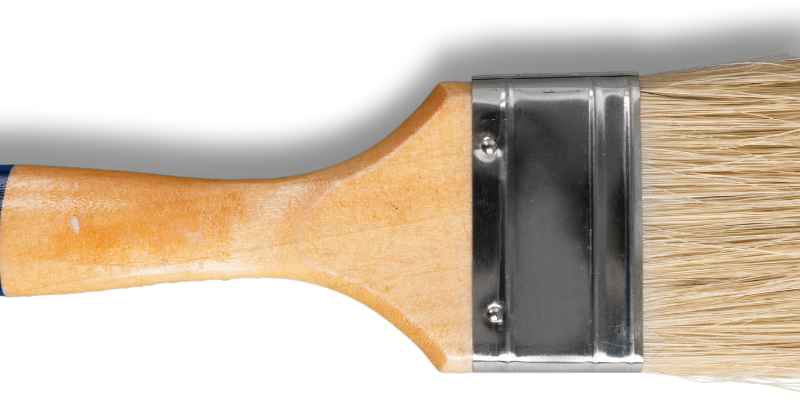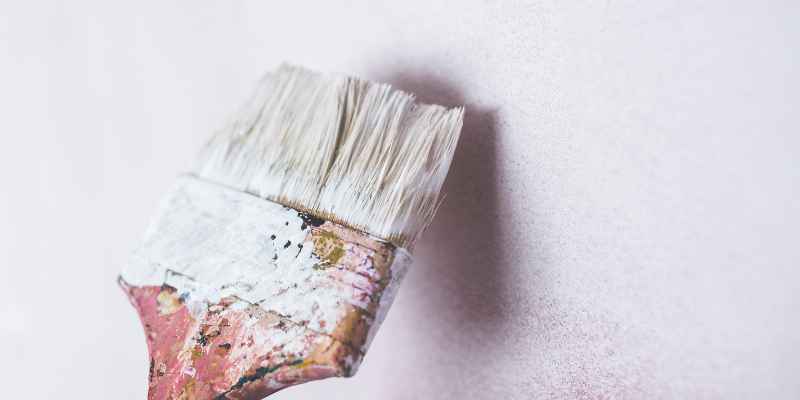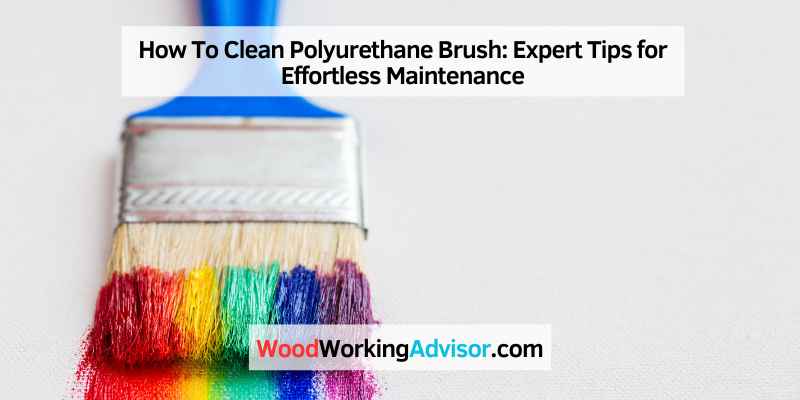To clean a polyurethane brush, rinse it under warm water and gently remove any excess paint or stain with soap. Then, use a brush comb or wire brush to remove any hardened residue, and rinse again thoroughly.
Dry the brush with a cloth or paper towel, making sure to reshape the bristles.
Why Clean Polyurethane Brushes?
Proper cleaning of polyurethane brushes is essential for several reasons. By understanding the importance of maintaining clean brushes, you can ensure the longevity of your tools, prevent buildup and clumping of polyurethane, and maintain a consistent finish application.
Prolongs Brush Lifespan
Cleaning your polyurethane brushes regularly can significantly prolong their lifespan. Over time, residue from polyurethane can accumulate on the bristles, making them stiff and compromising their effectiveness. By thoroughly cleaning the brushes after each use, you can keep the bristles soft and pliable, extending their longevity and saving you money in the long run.
Prevents Buildup And Clumping Of Polyurethane
When polyurethane is left to dry on the bristles of your brush, it can lead to a buildup of hardened residue. This buildup not only makes the brush less effective in applying polyurethane evenly, but it can also result in clumps or streaks in your finished work. Regular cleaning prevents this buildup, ensuring a smooth and consistent polyurethane application each time.
Maintains Consistent Finish Application
One of the key benefits of cleaning polyurethane brushes is that it helps maintain a consistent finish application. When brushes are not cleaned properly, dried polyurethane can mix with fresh product, resulting in an inconsistent finish. By regularly cleaning your brushes, you ensure that each application of polyurethane is free from any remnants of previous use, ensuring a smooth and even final result.

Materials Needed For Cleaning
To clean a polyurethane brush, gather materials such as warm water, mild soap, and a clean cloth. Gently wash the brush bristles with the soapy water, rinse thoroughly, and allow it to air dry before storing.
If you’ve been working with polyurethane and want to keep your brushes in great condition, cleaning them properly is essential. To clean a polyurethane brush, you’ll need a few materials:
- Mineral spirits
- A container
- Clean cloth or paper towels
Using these materials, you can effectively remove the polyurethane from your brush, ensuring it stays in top shape and ready for your next project.
Mineral Spirits
Mineral spirits are a key component in cleaning polyurethane brushes. They act as a solvent, breaking down and dissolving the polyurethane residue from the bristles. When choosing mineral spirits, make sure to go for the odorless kind as they are more eco-friendly and safer to use. It’s important to have mineral spirits ready before starting the cleaning process.
A Container
Next, you’ll need a container to hold the mineral spirits during the cleaning process. You can use any suitable container, such as a glass jar or a plastic container. The container should be large enough to hold the brush without bending or compressing the bristles. Ensure the container is clean and free from any debris or contaminants before pouring in the mineral spirits.
Clean Cloth Or Paper Towels
A clean cloth or paper towels are necessary for wiping off excess polyurethane and ensuring the brush is thoroughly cleaned. Use a lint-free cloth or absorbent paper towels to gently remove the dissolved polyurethane from the brush. It’s important to use a clean cloth or paper towels for effective cleaning and to avoid any debris or particles from sticking back onto the brush.
Now that you have the materials needed for cleaning, we can move on to the actual process of cleaning a polyurethane brush. Remember to always follow safety precautions when working with mineral spirits and other cleaning materials.
Step-by-step Cleaning Process
Clean your polyurethane brush using this step-by-step process. Remove excess paint with a paper towel, rinse the brush under warm water, and cleanse with mild dish soap. Allow it to dry thoroughly before use.
Step 2: Remove Excess Polyurethane
Before beginning the cleaning process, it is important to first remove any excess polyurethane from the brush. Take a rag or paper towel and gently wipe off as much of the polyurethane as possible. This will make the cleaning process more effective and prevent any leftover residue from drying on the brush.
Step 3: Soak The Brush In Mineral Spirits
Once the excess polyurethane has been removed, the next step is to soak the brush in mineral spirits. Fill a container or jar with enough mineral spirits to fully submerge the bristles of the brush. Carefully place the brush in the container, making sure that the bristles are completely covered in the liquid.
Step 4: Gently Clean The Brush Bristles
With the brush soaking in the mineral spirits, it’s time to gently clean the bristles. Use your fingers to massage the bristles, working the mineral spirits into the brush. This will help to dissolve and loosen any remaining polyurethane that may be stuck in the bristles.
Note: Be careful not to apply too much pressure or scrub the bristles too vigorously, as this could damage the brush.
Step 5: Rinse And Dry The Brush
After massaging the bristles with mineral spirits, it’s time to rinse and dry the brush. Take the brush out of the container and rinse it under warm running water. Make sure to thoroughly rinse out any remaining mineral spirits and polyurethane from the bristles.
Tip: Use your fingers to gently squeeze and reshape the bristles as you rinse to ensure that all the residue is removed.
Once the brush has been properly rinsed, gently pat it dry with a clean towel or paper towel. Make sure to remove as much moisture as possible from the bristles to prevent any mold or mildew from forming.
Step 6: Store The Brush Properly
The final step in the cleaning process is to store the brush properly. Proper storage ensures that the brush remains in good condition and is ready for future use. Hang the brush upside down or place it in a brush keeper to prevent the bristles from bending or becoming misshapen.
Tip: Store the brush in a cool, dry place away from direct sunlight to maintain its quality.

Tips And Best Practices
When it comes to cleaning polyurethane brushes, following the right tips and best practices will ensure that your brushes stay in good condition and can be reused multiple times. Here are some essential guidelines to follow:
Clean Brushes Immediately After Use
After using a polyurethane brush, it’s crucial to clean it thoroughly as soon as possible. Letting the polyurethane dry on the brush can make it extremely difficult to remove. By cleaning it immediately, you prevent the polyurethane from hardening and prolong the life of your brush.
Avoid Using Excessive Force
While cleaning the brush, it’s important not to apply excessive force. This can cause the bristles to become damaged or distorted, which affects the brush’s performance. Instead, gently remove the excess polyurethane by wiping it off with a cloth or paper towel.
Avoid Soaking Brushes For Too Long
Soaking polyurethane brushes for an extended period can cause the bristles to become loose or even fall out. Limit the soaking time to a few minutes, allowing the polyurethane to loosen. Afterward, use a brush comb or your fingers to gently remove any remaining residue.
Consider Using Specialized Brush Cleaners
Using a specialized brush cleaner can make the cleaning process much more effective. These cleaners are designed to break down the polyurethane and make it easier to remove. Follow the manufacturer’s instructions and use the cleaner as directed for optimum results.
Inspect Brushes For Any Damage
Prior to using your polyurethane brushes, always inspect them for any signs of damage. Look for bent or misshapen bristles, loose ferrules, or any other issues that might affect the brush’s performance. By ensuring your brushes are in good condition, you’ll achieve better results and extend their lifespan.
Conclusion
Cleaning a polyurethane brush is a simple process that can help maintain the longevity and performance of the brush. By following the steps outlined you can effectively remove any residual polyurethane from your brush and keep it in optimal condition for future use.
Remember to use proper cleaning agents and techniques to ensure the best results. With these tips, you’ll be able to clean your polyurethane brush with ease and keep it in top shape for all your woodworking projects


